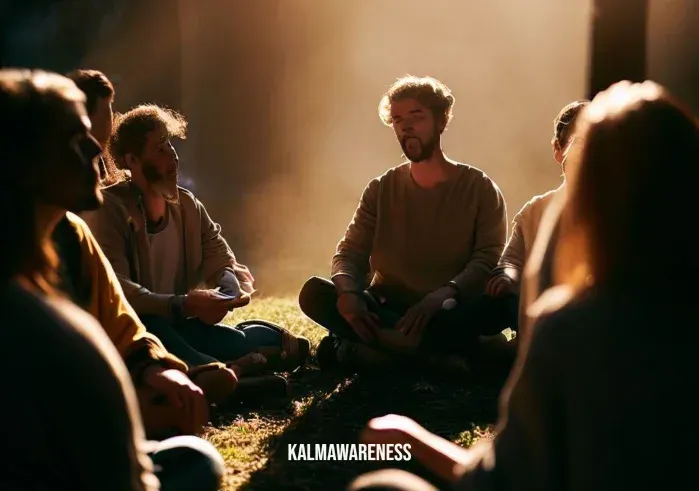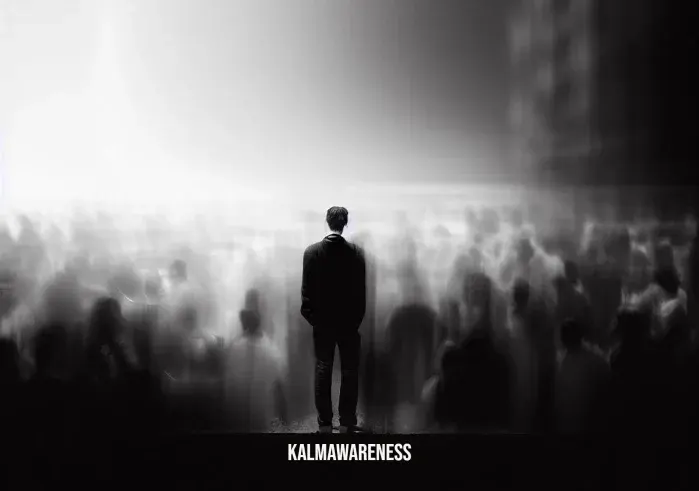Image of Acceptance: Embracing the Person in the Mirror
How often do you really see the person reflected in the mirror? The image of acceptance is more than just recognising our physical attributes, it’s a journey towards embracing our authentic selves. This article aims to guide you on this journey of self-discovery and acceptance, helping you navigate the winding road towards loving the person in the mirror.
We begin this exploration by addressing the very foundation of our relationship with ourselves—our self-image. The cornerstone of acceptance is a strong self-image, the mental representation we carry of ourselves, that guides our thoughts, actions, and responses. But what happens when we look in the mirror, and the image reflected doesn’t align with the person we believe ourselves to be?
Rethinking Your Self-Image
Understanding the concept of self-image and its impact on our lives is a crucial step in fostering acceptance. The picture we hold of ourselves isn’t always accurate. It’s often skewed by our emotions, personal experiences, and societal expectations. Many of us suffer from looking in the mirror and not recognizing ourselves, a disconnection that can lead to negative self-perception and decreased self-esteem.
Working on being in love with the person in the mirror involves a continuous process of challenging and reshaping our self-image. This requires patience, persistence, and a good dose of self-compassion.
“Your self-image is a compass, not a destination. It should guide you, not define you.”
Cultivating Self-Compassion
Acceptance isn’t about pretending we’re perfect or discarding parts of ourselves we deem flawed. Instead, it’s about cultivating the power of self-kindness, and understanding that imperfection is a part of our shared human experience.
Self-compassion is a powerful tool in navigating the path to acceptance. This involves practicing kindness towards ourselves, recognizing our shared humanity, and maintaining a balanced approach to our emotions. Consider creating a self-compassion mantra to gently remind you of your commitment to self-love and acceptance.
Embracing self-compassion enables us to see ourselves clearly, without the distortions of self-judgment. As we soften the lens through which we view ourselves, we move closer to the person we are, accepting our imperfections as part of our unique story.
I invite you to continue exploring the journey towards self-acceptance in the next part of this article. Learn about the role of mindfulness and meditation in fostering acceptance, the power of letting go, and how to redefine our understanding of desire on the path towards acceptance. Join me as we delve deeper into these transformative aspects of personal growth.

The Role of Mindfulness in Acceptance
Mindfulness, a core tenet of personal growth, plays a vital role in cultivating an image of acceptance. As we become more mindful, we make a deliberate effort to stay present, acknowledging our thoughts and emotions without judgment. In doing so, we give ourselves permission to truly see the person in the mirror and accept them, just as they are.
By consciously embracing mindfulness, we foster an environment where self-acceptance can flourish. This does not mean that we deny our weaknesses or our flaws, but rather, we recognize them as part of our authentic selves. Here’s a simple list to help you practice mindfulness:
- Pause: Slow down and pay attention to your internal state.
- Observe: Take note of your thoughts and feelings, without judgment.
- Breathe: Take a deep breath and ground yourself in the present moment.
- Accept: Acknowledge your emotions and experiences as valid and real.
- Respond: Make mindful decisions, rather than react out of impulse.
Meditation for Acceptance
Guided meditation can be a powerful tool for cultivating acceptance. It helps us connect with our inner selves, and overcome feelings of shame, guilt or inadequacy that often distort our self-image.
For instance, a shame meditation focuses on processing and releasing feelings of shame, an emotion that can severely impact our ability to accept ourselves. Meditation teaches us to treat these negative emotions with compassion, ultimately leading us towards self-acceptance.
Letting Go of Desire
Often, our self-image is clouded by our desires—how we wish to be seen, what we aspire to be, or what we think we should be. In these cases, learning how to let go of desire is an essential step towards self-acceptance.
It’s important to remember that letting go of desire isn’t about relinquishing our goals or aspirations. Rather, it’s about understanding that our worth isn’t determined by these external factors. As the saying goes, “what you resist, persists“. By releasing these desires, we can begin to accept ourselves as we truly are, not as we wish we were.
The following table outlines some common desires, their potential impacts on our self-image, and strategies for letting go.
| Desire | Impact on Self-Image | Strategy for Letting Go |
|---|---|---|
| Desire for Approval | Leads to dependence on others for self-esteem | Practice self-validation |
| Desire for Perfection | Creates unrealistic standards, leading to self-criticism | Embrace the imperfectable nature of humanity |
| Desire for Control | Promotes an image based on control rather than authenticity | Practice surrender and acceptance |
| Desire for Success | Equates self-worth with achievement | Understand the distinction between self-worth and success |
| Desire to Change | Promotes dissatisfaction with current self | Cultivate gratitude and acceptance for who you are now |
In the next part of this article, we’ll explore how to harness the power of self-compassion to further cultivate an image of acceptance, delving into practical exercises, and exploring the link between body compassion and self-acceptance. As we journey further into this topic, remember that every step you take is a step towards greater acceptance and love for the person in the mirror.

Harnessing the Power of Self-Compassion
As we continue our exploration of the “image of acceptance”, we move towards another key facet of this journey – self-compassion. The Buddha once said, “You, yourself, as much as anybody in the entire universe, deserve your love and affection.” This underscores the importance of self-compassion in accepting ourselves fully.
Defining Self-Compassion
What exactly is self-compassion? It’s the act of treating oneself with the same kindness, understanding, and patience that we’d extend to a close friend. It requires us to suspend harsh judgments and criticisms, offering instead empathy and care. Understanding the body compassion definition can help enhance our understanding of this concept, as it urges us to approach our physical selves with kindness and acceptance.
The Role of Self-Compassion in Acceptance
Our journey towards a healthier image of acceptance is intrinsically tied to self-compassion. The latter provides a pathway to the former, creating an environment of kindness where acceptance can grow. In the words of Kristin Neff, “With self-compassion, we give ourselves the same kindness and care we’d give to a good friend.”
Through self-compassion, we’re able to look in the mirror and not only recognize our flaws but also respond to them with understanding, rather than judgment or shame. This, in turn, allows us to accept ourselves as we are, fostering a positive self-compassion image.
Cultivating Self-Compassion
So, how do we cultivate self-compassion? It’s a process that requires practice and patience. One practical way to do this is by writing a self-compassionate letter.
Think of something about yourself that makes you feel inadequate or flawed. Then, write a letter to yourself from the perspective of a compassionate and understanding friend. This exercise helps to shift our perspective and encourages us to be kinder and more accepting of ourselves.
It’s also beneficial to develop a self-compassion mantra. This is a set of phrases that you can repeat to yourself in times of stress or self-doubt. The phrases are designed to bring comfort, remind you of your common humanity, and encourage mindfulness.
The Impact of Self-Compassion
Embracing self-compassion can have a profound impact on our lives. It teaches us that our value is not tied to external accomplishments or the approval of others. As the poet and philosopher Ralph Waldo Emerson wisely said, “To be yourself in a world that is constantly trying to make you something else is the greatest accomplishment.”
Ultimately, self-compassion allows us to accept our strengths and our flaws, our successes and our failures, without judgment. It fosters a healthier and more realistic self-image, enabling us to meet the person in the mirror with acceptance and love.
In the next chapter, we’ll explore the role of patience and mindfulness in enhancing self-acceptance. We’ll delve into various exercises that can help cultivate these qualities, supporting our journey towards a loving and accepting self-image.

The Importance of Patience and Mindfulness in Self-Acceptance
A cornerstone of building a positive “image of acceptance” lies in the practice of patience and mindfulness. Famed author Paulo Coelho once said, “Patience is not about waiting, but the ability to keep a good attitude while waiting.” Indeed, as we journey towards self-acceptance, the significance of patience cannot be overstated.
Understanding Patience
Patience is more than merely waiting. It’s about maintaining a positive and hopeful attitude even when things don’t seem to be progressing as quickly as we’d like. It’s about accepting that change takes time, and self-improvement is not a race but a marathon.
In the context of building an image of acceptance, patience means allowing ourselves the time and space to grow, change, and accept ourselves, without rushing the process or falling prey to frustration. It’s about remembering, as Maxime Lagacé says, “Patience is the calm acceptance that things can happen in a different order than the one you have in mind.”
The Role of Mindfulness
Just as patience is about maintaining a positive attitude while waiting, mindfulness involves bringing our full attention to the present moment, acknowledging our feelings, thoughts, and bodily sensations without judgment. It’s a tool that promotes self-acceptance and compassion.
A powerful way to practice mindfulness is through guided shower meditation. By focusing on the sensation of the water, the sound it makes, and the smell of your shower gel, you’re drawing your attention to the present moment, encouraging acceptance of what is, without striving for what could be.
Thich Nhat Hanh, a renowned Buddhist monk, says, “The present moment is filled with joy and happiness. If you are attentive, you will see it.” Indeed, embracing mindfulness can help us see the beauty of our present selves, further fostering our image of acceptance.
Impact of Patience and Mindfulness
Cultivating patience and mindfulness can have a profound impact on our self-acceptance journey. They remind us that we are works in progress and that change takes time. Additionally, by being fully present and patient with ourselves, we can foster a more positive self-image and ultimately cultivate a powerful image of acceptance.
Moreover, when we practice mindfulness, we learn to observe our thoughts and feelings without judgment, allowing us to meet ourselves with compassion and understanding. In this way, mindfulness can help us better accept ourselves as we are, promoting a healthier self-image.
| Definition | Benefit | Practice | Role in Self-Acceptance | Famous Quote | |
|---|---|---|---|---|---|
| Patience | The ability to endure difficult circumstances | Fosters resilience, reduces stress | Accept things as they are, keep a positive attitude while waiting | Helps us embrace our growth journey with kindness and understanding | “Patience is the calm acceptance that things can happen in a different order than the one you have in mind.” – Maxime Lagacé |
| Mindfulness | The practice of focusing one’s awareness on the present moment | Promotes emotional well-being, improves focus | Engage in mindful meditation, pay attention to bodily sensations | Encourages non-judgmental acknowledgment of our thoughts and feelings | “The present moment is filled with joy and happiness. If you are attentive, you will see it.” – Thich Nhat Hanh |
In the next chapter, we’ll explore the transformative power of letting go and how it contributes to shaping our image of acceptance. We’ll discuss practical steps to cultivate this skill, its benefits, and how it complements the practices of self-compassion, patience, and mindfulness in our self-acceptance journey.

Embracing Imperfections and Cultivating Self-Kindness for an Image of Acceptance
“There is a kind of beauty in imperfection.” – Conrad Hall
Each one of us is perfectly imperfect. Our flaws and imperfections are what make us unique, real, and human. Embracing these ‘imperfections’ is an essential step in building a healthier image of acceptance.
Accepting Imperfection
“Imperfection is not our personal problem, it is a natural part of existing.” – Tara Brach
Life is a grand tapestry of experiences, interwoven with countless threads of mistakes, triumphs, and lessons learned. Accepting imperfection is about acknowledging that every thread, no matter how messy or tangled, contributes to the overall beauty of the tapestry. It’s about appreciating our imperfectable nature and understanding that there is no such thing as a perfect human being.
Recognizing that we don’t look like what we see in the mirror all the time, and that’s perfectly okay, is an essential part of this journey. Embracing our imperfections fosters self-acceptance, promoting a healthier self-image and an image of acceptance that encompasses every facet of our being.
Cultivating Self-Kindness
“Be kind to yourself. Remember, we’re all doing the best we can with what we know.” – Brené Brown
Cultivating self-kindness means treating ourselves with the same compassion and understanding we’d offer a friend. It’s about acknowledging our struggles and feelings without self-judgment, meeting our shortcomings with kindness, and nurturing our strengths with appreciation.
Practicing self-kindness involves mindful awareness of our internal dialogue. Are we harsh and critical, or are we understanding and encouraging? Are we dismissive of our accomplishments, or do we celebrate our victories, no matter how small?
Furthermore, self-kindness also includes taking care of our physical health. Activities such as practicing guided shower meditation or simply taking a deep breath can greatly contribute to our overall well-being and self-acceptance.
Impact of Embracing Imperfection and Cultivating Self-Kindness
Embracing imperfection and cultivating self-kindness create a strong foundation for self-acceptance. They enable us to appreciate ourselves for who we are, with all our strengths and weaknesses. They encourage us to extend compassion and understanding to ourselves, creating an image of acceptance that is both realistic and empowering.
When we accept our imperfections and are kind to ourselves, we cultivate a sense of self-love that radiates outward, influencing how we interact with others and the world around us. We begin to see ourselves as deserving of love and kindness, not despite our imperfections, but because of them.
By practicing self-kindness and embracing our imperfect nature, we construct an image of acceptance that is grounded in compassion and authenticity. We learn to see ourselves in a more positive and accepting light, promoting personal growth and overall well-being.
“You, yourself, as much as anybody in the entire universe, deserve your love and affection.” – Buddha
In our final chapter, we will explore how we can manifest the lessons of acceptance, mindfulness, patience, letting go, embracing imperfections, and self-kindness into our daily lives to further foster our image of acceptance. We will delve into practical exercises and tools that can be utilized to continually nurture self-acceptance. Stay with us as we bring together all these threads into a complete tapestry.

Weaving a Life Tapestry of Acceptance
“Only by accepting ourselves can we create an authentic life.” – Brené Brown
As we reach the final chapter, we hope that the journey so far has begun to sketch a clearer and more empowering image of acceptance. We all have an individual tapestry of experiences, emotions, flaws, and strengths that make us who we are. The task is not to remove or hide these threads, but rather to embrace them and weave them into a beautiful work of art.
Journey of Self-Discovery
“Knowing yourself is the beginning of all wisdom.” – Aristotle
The journey towards acceptance begins with self-discovery. It’s about taking the time to understand our emotions, our strengths, our weaknesses, and everything in between. It’s about acknowledging our fears, our passions, our dreams, and our insecurities. Only by knowing ourselves deeply can we truly begin to accept ourselves.
Nurturing Inner Peace
“Peace comes from within. Do not seek it without.” – Buddha
Once we embark on the journey of self-discovery, the next step is to nurture inner peace. It’s about learning to live in the present moment, to let go of the past, and not to worry about the future. It’s about learning to stay grounded amidst the storm of life’s uncertainties. Cultivating inner peace is a crucial part of developing a healthy image of acceptance.
Living a Life of Acceptance
“Life becomes easier when you learn to accept an apology you never got.” – Robert Brault
The final step in this journey is living a life of acceptance. It’s about applying all that we’ve learned and experienced in our everyday lives. It’s about creating an image of acceptance that goes beyond just us, influencing the way we interact with others and the world around us. It’s about practicing everyday mindfulness, cultivating patience, letting go, and extending self-kindness to every aspect of our lives.
Conclusion
“The only person who can pull me down is myself, and I’m not going to let myself pull me down anymore.” – C. JoyBell C.
Acceptance is not a destination; it’s a journey. It’s a continuous process of self-discovery, inner peace cultivation, and living a life that mirrors our authentic selves. Embracing our imperfections, practicing self-kindness, nurturing patience, and living mindfully are all threads that, when woven together, create an image of acceptance that is as beautiful and unique as we are.
As we bring this chapter to a close, we hope that you carry forward these lessons into your life. And remember, the journey towards acceptance is not linear. There will be highs and lows, progress and setbacks, but every step, no matter how small, is a step in the right direction.
We hope this journey with Kalm Awareness has been enlightening for you. We look forward to continuing to provide valuable insights and tools to foster your journey towards self-acceptance, mindfulness, and inner peace in our upcoming editions. Remember, every step, no matter how small, is a step in the right direction towards creating a healthier, happier, and more accepting you.
“Acceptance doesn’t mean resignation; it means understanding that something is what it is and that there’s got to be a way through it.” – Michael J. Fox
Here’s to creating a tapestry of acceptance that we can be proud of, together.





